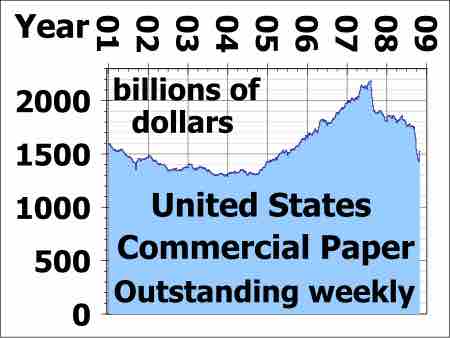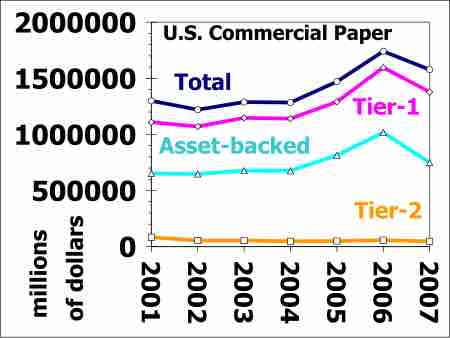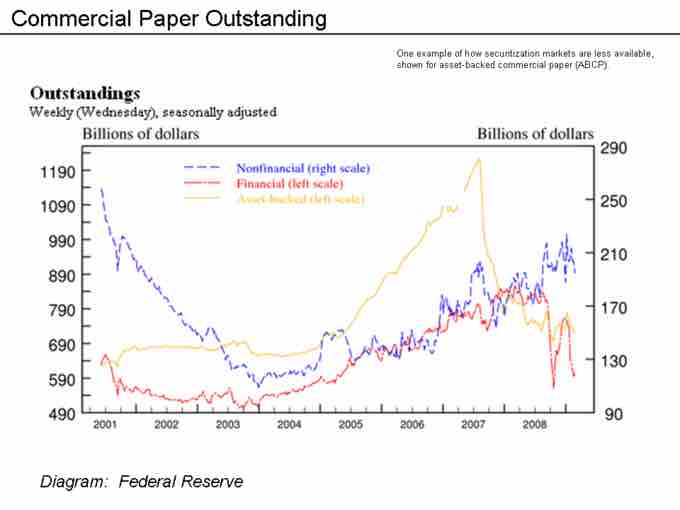Commercial Paper
In the global money market, commercial paper is an unsecured promissory note with a fixed maturity of one to 364 days. Commercial paper is a money-market security issued (sold) by large corporations to get money to meet short term debt obligations (for example, payroll), and is only backed by an issuing bank or a corporation's promise to pay the face amount on the maturity date specified on the note. Since it is not backed by collateral, only firms with excellent credit ratings from a recognized rating agency will be able to sell their commercial paper at a reasonable price. Commercial paper is usually sold at a discount from face value, and carries higher interest repayment rates than bonds. Typically, the longer the maturity on a note, the higher the interest rate the issuing institution must pay. Interest rates fluctuate with market conditions, but are typically lower than banks' rates.
There are two methods of issuing paper. The issuer can market the securities directly to a buy and hold investor such as most money market funds. Alternatively, it can sell the paper to a dealer, who then sells the paper in the market . The dealer market for commercial paper involves large securities firms and subsidiaries of bank holding companies. Most of these firms are also dealers in US Treasury securities. Direct issuers of commercial paper are usually financial companies that have frequent and sizable borrowing needs, and find it more economical to sell paper without the use of an intermediary. In the United States, direct issuers save a dealer fee of approximately five basis points, or 0.05% annualized, which translates to $50,000 on every $100 million outstanding. This saving compensates for the cost of maintaining a permanent sales staff to market the paper. Dealer fees tend to be lower outside the United States .

US Commercial Paper Weekly 2001-2008
United States Commercial Paper outstanding at end of each week from 3 January 2001 to 29 October 2008. Vertical scale shows debt in billions (thousands of millions) of dollars, horizontal scale shows years. Each blue marker indicates commercial paper outstanding at that date which matures after one week.

US Commercial Paper 2001-2007
United States Commercial Paper outstanding at end of each year 2001 to 2007. Vertical scale shows debt in millions of dollars, horizontal scale shows years. All markers indicate commercial paper outstanding, maturing after December 31. Circles on blue line indicate Total commercial paper; triangles diamonds on pink line indicate SEC rule 2a-7 tier-1 commercial paper; triangles on blue line indicate Asset-backed commercial paper; squares on yellow line indicate SEC rule 2a-7 tier-2 commercial paper.

Weekly Commercial Paper Outstandings
Commercial paper is a lower cost alternative to a line of credit with a bank. Once a business becomes established and builds a high credit rating, it is often cheaper to draw on a commercial paper than on a bank line of credit. Nevertheless, many companies still maintain bank lines of credit as a backup. Banks often charge fees for the amount of the line of the credit that does not have a balance.
Advantages and Disadvantages
Advantages of commercial paper include lower borrowing costs; term flexibility; and more liquidity options for creditors due to its trade-ability.
Disadvantages of commercial paper include its limited eligibility; reduced credit limits with banks; and reduced reliability due to its strict oversight.
Asset-Backed Commercial Paper (ABCP)
Asset-Backed Commercial Paper (ABCP) is a form of commercial paper that is collateralized by other financial assets. ABCP is typically a short-term instrument that matures between one and 180 days from issuance and is typically issued by a bank or other financial institution. The firm wishing to finance its assets through the issuance of ABCP sells the assets to a Special Purpose Vehicle (SPV) or Structured Investment Vehicle (SIV), created by a financial services company. The SPV/SIV issues the ABCP to raise funds to purchase the assets. This creates a legal separation between the entity issuing and the institution financing its assets.